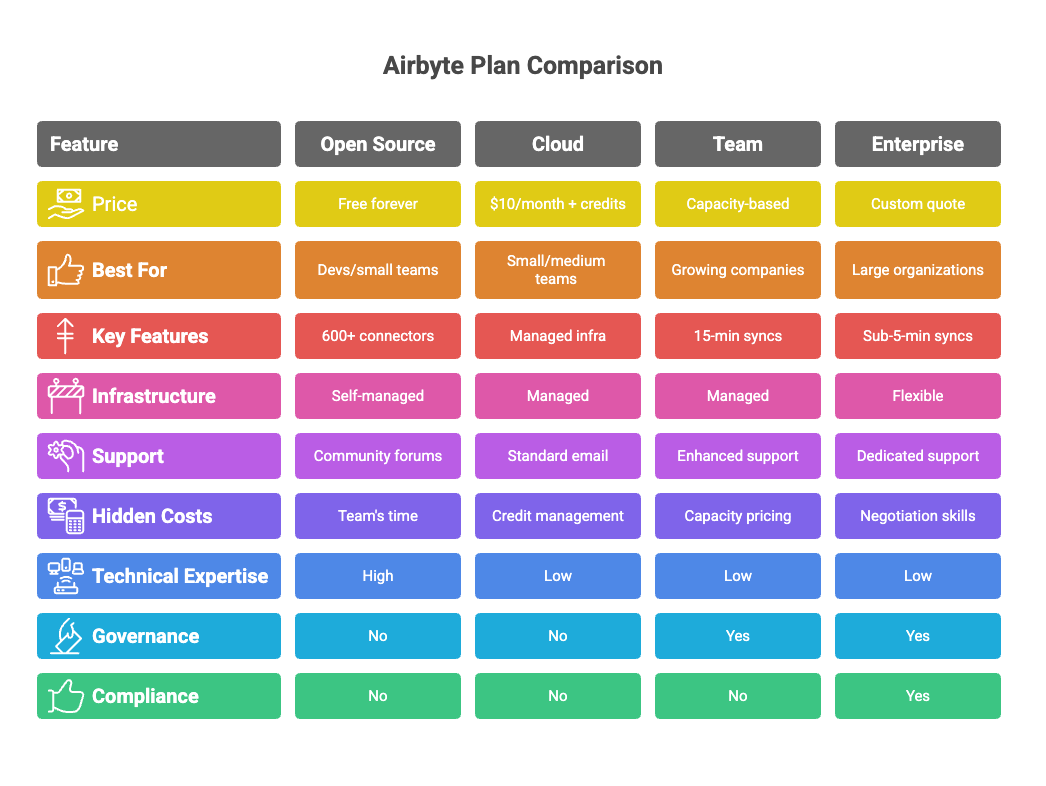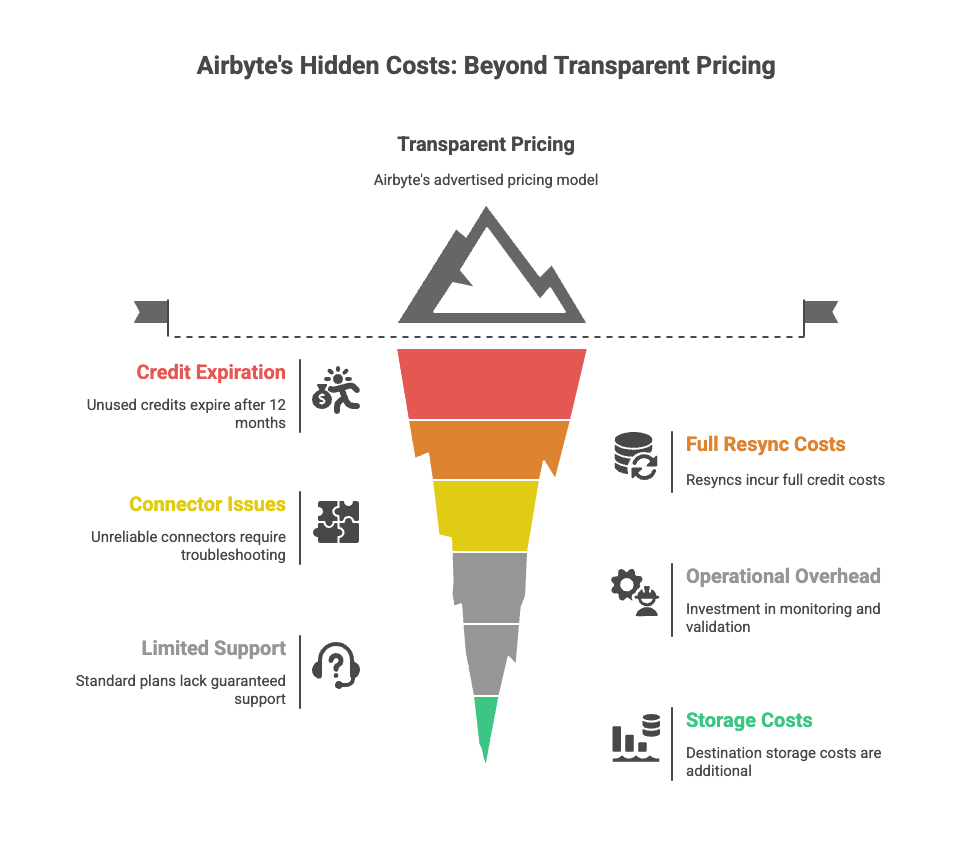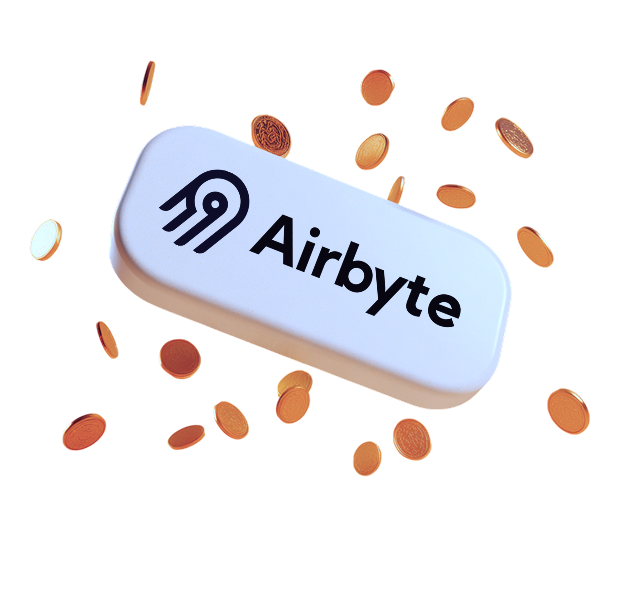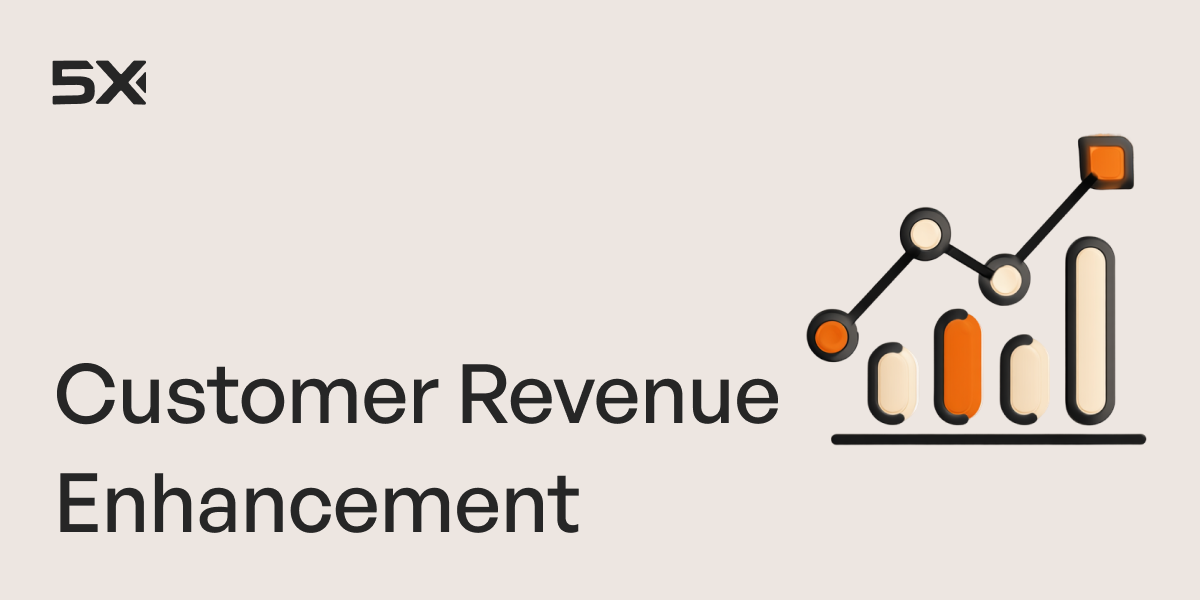Table of Contents
TL; DR
Thinking about Airbyte for your data integration needs? You're not alone. With over 40,000 companies using Airbyte and more than 900 contributors to their open-source platform, it's become one of the most talked-about data integration solutions in the market. But before you dive in, let's cut through the marketing fluff and give you the real story about what you'll actually pay.
Spoiler alert: it's more complicated than their "simple pricing" claims suggest. While Airbyte markets itself as having transparent, flexible pricing, the reality involves credit systems, connector limitations, and hidden costs that can surprise even experienced data teams. In this comprehensive guide, we'll break down every aspect of Airbyte's pricing structure and show you exactly what to expect.
Understanding airbyte's business model
Before diving into specific pricing, it's important to understand how Airbyte positions itself in the data integration market. Founded in 2020, Airbyte has grown rapidly by focusing on the "democratization of data movement." Their approach combines open-source accessibility with commercial cloud offerings, creating multiple pricing tiers designed to serve everyone from individual developers to enterprise organizations.
The company's strategy revolves around providing the largest catalog of data connectors (600+ in open source, 550+ in cloud) while maintaining flexibility in deployment options. This approach has attracted significant investment and a large community, but it also creates complexity in their pricing structure that users need to understand.
Airbyte pricing plans: what you actually pay

Open source plan
- Price: Free forever
- Best for: Developers and small teams who can manage their own infrastructure
- What you get: Access to 600+ connectors, full control over your data pipelines, no vendor lock-in
- Infrastructure requirements: You need to provision and maintain your own servers, databases, and monitoring systems.
- Hidden cost: Your team's time for setup, maintenance, troubleshooting, and ongoing updates
- Technical expertise needed: Docker, Kubernetes, database management, and monitoring setup
-
The open-source version gives you complete control but requires significant technical investment. Many teams underestimate the ongoing maintenance burden, which can easily consume 20-40 hours per month for a moderately complex setup.
Cloud plan
- Price: $10/month base fee + credit consumption
- What's included: 4 credits (worth $10), managed infrastructure, automatic updates
- After that: $2.50 per credit for additional usage
- Best for: Small to medium teams with predictable data volumes who want managed infrastructure
- Sync frequency: Minimum 1-hour intervals
- Support: Standard email support with community forums
The Cloud plan removes infrastructure management but introduces the complexity of credit management and usage prediction. Most teams find their actual costs are 3-5x higher than initial estimates due to underestimating data volumes and sync frequency needs.
Team plan
- Price: Capacity-based pricing (typically starts around $500-1000/month)
- Best for: Growing companies needing governance features and faster sync frequencies
- Key features: 15-minute sync intervals, user management, project-level permissions, audit logs
- Governance: Advanced security features, compliance reporting, data lineage tracking
- Support: Enhanced support with faster response times
The Team plan represents Airbyte's push toward enterprise features. The capacity-based pricing model is designed to provide more predictable costs, but many users report that the transition from volume-based to capacity-based pricing can be confusing during the evaluation process.
Enterprise plan
- Price: Custom quotes (typically $5,000+ monthly minimums)
- Best for: Large organizations with strict security, compliance, and performance requirements
- Features: Sub-5-minute syncs, advanced security controls, custom SLAs, dedicated support
- Deployment options: single-tenant cloud, hybrid deployment, on-premises options
- Compliance: SOC 2, GDPR, and HIPAA compliance features
Enterprise pricing is heavily negotiable and often includes volume discounts, multi-year commitments, and custom feature development. Companies report final pricing can vary by 40-60% based on negotiation skills and competitive alternatives.
How airbyte credits work
Credits are Airbyte's universal currency for measuring and billing data movement across their platform. Understanding how credits are consumed is crucial for accurate cost prediction and budget planning. The credit system was designed to unify billing across different types of data sources, but it can create confusion for teams used to simple per-connector or flat-rate pricing.
Here's what 1 credit ($2.50) gets you across different source types:
Credit consumption patterns
Understanding how credits are actually consumed in real-world scenarios is essential for budget planning.
Initial Historical Sync: When you first connect a data source, Airbyte performs a complete historical sync of all available data. This can consume significant credits upfront. For example, syncing 5 years of historical sales data (500 million rows) would cost approximately $7,500 in credits.
Incremental Updates: After the initial sync, Airbyte only syncs new, modified, or deleted data. This dramatically reduces ongoing credit consumption. A typical incremental sync might only process 1-5% of the total data volume.
Schema Changes: When your data source schema changes, Airbyte may need to perform a full resync, consuming credits as if it were a new historical sync.
Failed Syncs: If a sync fails partway through, you still pay for the credits consumed up to that point. Airbyte doesn't refund credits for failed operations.
Detailed real-world cost examples
To help you understand what Airbyte will actually cost your organization, let's examine several realistic scenarios based on common use cases we see in the market:
Scenario 1: Small SaaS Startup
Company Profile: 50-person B2B SaaS company with basic analytics needs Data Sources: Stripe (payments), HubSpot (CRM), Google Analytics, PostgreSQL database
Monthly Volume: 5 million API rows + 2 GB database data Sync Frequency: Daily for most sources, hourly for critical payment data
Cost Breakdown:
- API data: 5M rows × $15/million = $75
- Database data: 2 GB × $10/GB = $20
- Base Cloud plan: $10/month
- Total Monthly Cost: $105
- Annual Cost: $1,260
Hidden costs to consider: 2-3 days of engineering time for initial setup ($3,000-4,500 value), ongoing maintenance (~4 hours monthly = $400-600/month in engineering time).
Scenario 2: Growing E-commerce Company
Company Profile: 200-person online retailer with multiple sales channels Data Sources: Shopify, Amazon Seller Central, Facebook Ads, Google Ads, Zendesk, multiple databases Monthly Volume: 50 million API rows + 50 GB database/file data Sync Frequency: Hourly for sales data, daily for marketing data
Cost Breakdown:
- API data: 50M rows × $15/million = $750
- Database/file data: 50 GB × $10/GB = $500
- Total Monthly Cost: $1,250
- Annual Cost: $15,000
Growth considerations: This company's data volumes typically grow 20-30% annually, meaning costs could reach $20,000+ within two years.
Scenario 3: Mid-Size Enterprise
Company Profile: 1,000-person technology company with complex data needs Data Sources: 15+ SaaS applications, multiple databases, file systems, custom APIs Monthly Volume: 500 million API rows + 500 GB database/file data Sync Frequency: Real-time for critical systems, hourly for others
Cost Breakdown:
- API data: 500M rows × $15/million = $7,500
- Database/file data: 500 GB × $10/GB = $5,000
- Team/Enterprise plan features: $2,000-5,000
- Total Monthly Cost: $14,500-17,500
- Annual Cost: $174,000-210,000
Enterprise considerations: At this scale, companies typically negotiate 30-50% discounts, bringing actual costs to $120,000-150,000 annually.
Hidden Costs and Gotchas: What Airbyte Doesn't Tell You Upfront
While Airbyte's marketing emphasizes transparent pricing, there are several hidden costs and complexities that can significantly impact your total cost of ownership:
1. Credit Expiration Policy
Unused credits expire after exactly 12 months from the purchase date. There are no refunds, extensions, or rollovers. This policy particularly impacts organizations with seasonal data patterns or those who purchase credits in bulk for discounts.
Real impact: A company that bought $10,000 in credits with a 40% bulk discount lost $3,000 in unused credits due to a project delay that reduced their data volumes.
2. Full Resync Costs
When schema changes occur, data source issues arise, or you need to reload historical data, Airbyte performs a complete resync at full credit cost. Unlike incremental syncs, resyncs don't have any cost protection.
Common resync triggers:
- Database schema changes (adding/removing columns)
- Data source API changes
- Connector updates that require a full refresh
- Data quality issues requiring complete reload
Cost example: A resync of 100 GB of database data costs $1,000 in credits, regardless of how recently you performed the last sync.
3. Connector Maturity and Reliability Issues
Many of Airbyte's 600+ connectors are community-contributed and marked as "Alpha" or "Beta." These connectors often have reliability issues, missing features, or compatibility problems that require significant engineering time to resolve.
Production readiness breakdown:
- Generally Available (GA): ~200 connectors
- Beta: ~200 connectors
- Alpha: ~200 connectors
Hidden cost: Teams report spending 10-20 hours monthly troubleshooting connector issues, equivalent to $1,500-3,000 in engineering time.
4. Infrastructure and Operational Overhead
Even with the Cloud plan, organizations need to invest in
- Data monitoring and alerting systems
- Error handling and retry logic
- Data quality validation
- Performance optimization
- Security and compliance auditing
5. Limited Support and SLA Coverage Standard Cloud plans include only email support with no guaranteed response times. Many critical issues require community forum assistance or upgrading to higher-tier plans.
6. Data Transfer and Storage Costs
Airbyte's pricing covers data movement but not the destination storage costs. Depending on your data warehouse choice, storage and compute costs can equal or exceed Airbyte's fees.
Typical additional costs:
- Snowflake: $2-4 per TB stored monthly
- BigQuery: $20 per TB stored monthly
- Redshift: $1-3 per TB stored monthly
- Plus compute costs for queries and transformations
What Real Users Say: Honest Feedback from the Trenches

To give you a balanced perspective, here's what actual Airbyte users report about their experience with pricing and the platform:
Positive Experiences:
Cost Savings Success Stories:
- "We negotiated a 40% discount by comparing with Fivetran and leveraging our volume commitment."
- "For our specific use case with mostly database sources, Airbyte is significantly cheaper than alternatives."
- "The open-source version saved us $50,000+ annually compared to enterprise ETL tools."
Flexibility Appreciation:
- "Being able to customize connectors when needed has been invaluable."
- "The ability to self-host gives us complete control over our data sovereignty."
- "The credit system allows us to optimize costs by adjusting sync frequencies."
Common Complaints and Challenges:
Pricing Complexity:
- "The pricing model isn't straightforward—it's difficult to predict usage and costs as data volumes increase."
- "Credit expiration caught us off guard and cost us $5,000 in unused credits."
- "Estimating costs for new data sources is nearly impossible without running them first."
Operational Challenges:
- "Many connectors aren't production-ready; we spend significant time troubleshooting."
- "Support response times are inconsistent unless you're on enterprise plans."
- "Schema changes requiring full resyncs can blow up your monthly budget unexpectedly."
Hidden Complexity:
- "What seemed like a simple setup turned into weeks of engineering work."
- "Monitoring and maintaining connectors requires more expertise than expected."
- "Integration with our existing data infrastructure was more complex than advertised."
Industry Analyst Perspective
According to Gartner and other industry analysts, Airbyte represents the "democratization" trend in data integration, but organizations should carefully consider:
- Total cost of ownership beyond just license fees
- Technical expertise requirements for successful implementation
- Long-term maintenance burden and operational complexity
- Vendor maturity compared to established enterprise solutions
Decision Framework: When Airbyte Makes Sense
Making the right choice between Airbyte and alternatives depends on your organization's specific circumstances, technical capabilities, and priorities.
Choose Airbyte if:
Technical Capabilities:
- You have dedicated data engineering resources (2+ engineers with relevant experience).
- Your team is comfortable with Docker, Kubernetes, and cloud infrastructure.
- You can invest 40-80 hours initially for proper setup and configuration.
- You have monitoring and alerting infrastructure in place.
Business Requirements:
- Budget optimization is a top priority, and you're willing to trade simplicity for cost savings.
- Your data volumes are large enough to benefit from Airbyte's pricing model (typically 100M+ rows monthly).
- You need the flexibility to customize connectors or build new ones.
- Data sovereignty requirements favor self-hosted solutions.
- Your data sources include many niche or specialized systems.
Organizational Factors:
- You're comfortable being an early adopter and working with evolving technology.
- Your team can handle troubleshooting and maintenance as part of regular operations.
- You have time for a 2-4 month implementation and optimization period.
Skip Airbyte if:
Technical Limitations:
- Your team lacks data engineering expertise or is already at capacity.
- You need guaranteed uptime and SLAs for business-critical data pipelines.
- You prefer turnkey solutions that work out of the box.
- Your organization has strict compliance requirements needing mature governance features.
Business Priorities:
- Time to value is more important than cost optimization.
- You want predictable, simple pricing without usage complexity.
- Your data volumes are small to medium (under 50M rows monthly).
- You need enterprise-grade support and account management.
Risk Tolerance:
- You can't afford downtime or data quality issues from connector problems.
- Your organization prefers proven, mature solutions over cutting-edge technology.
- You need extensive documentation and training resources for your team.
5X.co: The Simpler Alternative
While Airbyte requires you to become a data integration expert, 5X.co takes a different approach: they handle the complexity so you can focus on your business.
5X.co vs Airbyte: Key Differences
Real Customer Savings
5X.co customers report:
- 65% cost savings compared to traditional solutions
- 300+ hours saved monthly on manual work
- 30-50% lower total cost of ownership than multi-vendor approaches
What 5X.co Includes
Unlike Airbyte's pay-per-feature model, 5X.co provides everything in one platform:
- 600+ connectors with no additional fees
- Data warehousing (provision your own or integrate existing)
- Data modeling and transformation
- Business intelligence and dashboards
- AI-powered analytics
- Complete support and consulting
5X.co Pricing Philosophy
- Volume discounts that actually make sense
- No surprise charges from connector issues
- Predictable scaling costs
- The first use case is free to prove value.
- 48-hour implementation vs. months of setup
Is Airbyte best for you?
Airbyte's "simple" pricing is anything but simple. Between credit management, connector maintenance, and unpredictable costs, many teams find themselves spending more time managing their data integration tool than actually using their data.
5X.co offers a refreshingly different approach: transparent pricing, complete platform capabilities, and the expertise to get you up and running in days, not months.
The Choice:
- Airbyte: DIY approach with hidden complexity and costs
- 5X.co: Complete managed solution with predictable value
If you're tired of managing infrastructure and want to focus on insights instead of integration, 5X.co might be exactly what you're looking for.
Ready to see the difference? 5X.co offers a free consultation to analyze your current setup and show you exactly how much you could save while getting better results.
Building a data platform doesn’t have to be hectic. Spending over four months and 20% dev time just to set up your data platform is ridiculous. Make 5X your data partner with faster setups, lower upfront costs, and 0% dev time. Let your data engineering team focus on actioning insights, not building infrastructure ;)
Book a free consultationHere are some next steps you can take:
- Want to see it in action? Request a free demo.
- Want more guidance on using Preset via 5X? Explore our Help Docs.
- Ready to consolidate your data pipeline? Chat with us now.
Get notified when a new article is released
Try 5X - no hidden costs.
Try 5X - no hidden costs.

How retail leaders unlock hidden profits and 10% margins
Retailers are sitting on untapped profit opportunities—through pricing, inventory, and procurement. Find out how to uncover these hidden gains in our free webinar.
Save your spot






.png)


%201.svg)
.png)








